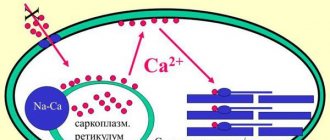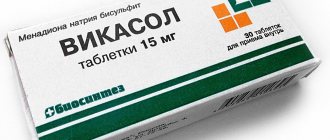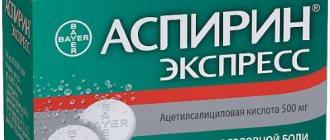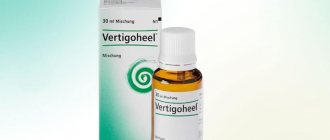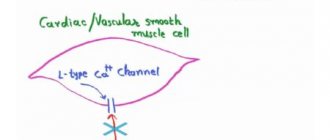Pharmacological properties of the drug Norvasc
Amlodipine (3-ethyl-5-methyl-2-(2-amino-ethoxymethyl)-4-(2-chlorophenyl)-1,4-dihydro-6-methyl-3,5-pyridinedicarboxylate benzenesulfonate) is a calcium ion antagonist ( blocker of slow calcium channels of cell membranes). Blocks the entry of calcium ions into the smooth muscle cells of the myocardium and blood vessels. The mechanism of the hypotensive effect of amlodipine is due to a direct effect on vascular smooth muscle. The antianginal effect of amlodipine is realized in two ways:
- amlodipine dilates peripheral arterioles and thus reduces afterload. Since heart rate remains virtually unchanged, a decrease in afterload on the heart leads to a decrease in energy consumption and myocardial oxygen demand;
- amlodipine directly dilates coronary arteries of different calibers both in unchanged and ischemic areas of the myocardium. This dilation increases the supply of oxygen to ischemic areas in patients with vasospastic angina (Prinzmetal's angina or variant angina) and prevents the development of coronary vasoconstriction.
In patients with hypertension (arterial hypertension), a single dose of amlodipine provides a clinically significant reduction in blood pressure within 24 hours both in the supine and standing positions. Due to the gradual onset of action, amplodipine does not cause the development of symptomatic hypotension. In patients with angina pectoris, a single dose of amlodipine increases the time of physical activity, delays the development of an attack of angina and ST during physical activity, reduces the frequency of angina attacks and reduces the need to take nitroglycerin. in vitro studies indicate that approximately 97.5% of amlodipine is bound to plasma proteins. Amlodipine does not have a negative effect on metabolism and the lipid spectrum of blood plasma; it can be used to treat patients with asthma, diabetes mellitus and gout. As a result of hemodynamic studies and controlled clinical trials in patients with heart failure II–III functional class (FC) according to the NYHA classification, it was revealed that amlodipine does not cause a deterioration in the condition of patients according to such criteria as exercise tolerance, left ventricular ejection fraction and clinical symptoms. In placebo-controlled studies evaluating patients with heart failure (NYHA class III-IV) treated with digoxin, diuretics and ACE inhibitors, it was found that amlodipine did not increase the mortality rate or composite mortality rate in patients with heart failure . After oral administration, amlodipine is well absorbed from the digestive tract, reaching maximum plasma concentrations after 6–12 hours. Bioavailability is 64–80%. The volume of distribution is approximately 21 l/kg. Food intake does not affect the absorption of amlodipine. The half-life is approximately 35–50 hours, which allows the drug to be administered once a day. A stable equilibrium concentration in the blood plasma is achieved after 7–8 days of continuous use of the drug. Amlodipine is biotransformed in the liver with the formation of inactive metabolites; 10% of the unchanged drug and 60% of the metabolites are excreted in the urine. In the elderly and in patients with congestive heart failure, there is a tendency for the clearance of amlodipine to decrease, which leads to an increase in AUC and half-life.
Interaction with other medications and analogues
Calcium antagonists are safe to take in combination therapy with beta-blockers, alpha-blockers, and thiazide-based diuretics.
Combined use is permissible with ACE inhibitors, nitrate-based drugs (Nitroglycerin), as well as oral hypoglycemic medications. It is also allowed to take antibacterial agents and calcium antagonists in complex treatment.
When taking amlodipine-based tablets, it is not allowed to drink grapefruit juice or eat fruits. Such combined use may lead to enhanced hypotensive effects on the body.
When combined with statins at a maximum dosage of 80 mg, the concentration of statins increases by 70-80%. Therefore, if concomitant therapy is required, statins should be prescribed in a dosage of no more than 20 mg. It is allowed to take it together with Warfarin, as well as with cardiac glycosides (Digoxin).
Pharmaceutical companies offer a wide range of analogues based on the active component amlodipine. Analogues of this product are produced by both Russian and foreign manufacturers. The choice of the drug, as well as its analogue, can only be made by the attending physician. The main medications that are prescribed to replace Norvasc and Amlodipine are:
Enalapril is a medication prescribed for hypertension, as well as for the treatment of attacks of angina and tachycardia.- Normodipine is a calcium antagonist similar in composition. The purpose and contraindications are the same as the original medications.
- Duactin is available in capsule form. Prescribed for chronic tachycardia complicated by hypertension. The medication has a minimal number of side effects.
- Tenox is a medication prescribed for severe hypertension and unstable angina. The medicine is not prescribed for severe heart failure.
Indications for use of the drug Norvasc
Treatment of hypertension (arterial hypertension) (as a first-line drug as monotherapy or combination therapy in combination with thiazide diuretics, α- and β-adrenergic receptor blockers, ACE inhibitors). Treatment of coronary artery disease, namely stable angina and vasospastic angina (variant angina or Prinzmetal angina). Reducing the risk of the need for myocardial revascularization and hospitalization for angina pectoris in patients with coronary artery disease. The drug can be used in cases where the clinical picture suggests the presence of vasospasm or vasoconstriction, although their presence has not been confirmed. Used as monotherapy or in combination with other antianginal drugs.
Side effects of the drug Norvasc
In placebo-controlled clinical trials involving patients with hypertension (arterial hypertension) and angina pectoris, the most commonly reported symptoms were headache, peripheral edema, fatigue, drowsiness, nausea, abdominal pain, flushing, palpitations and dizziness. In these clinical studies, no clinically significant changes in laboratory parameters due to Norvasc were noted. Significantly less often, with the widespread use of Norvasc, side effects such as alopecia, constipation, arthralgia, asthenia, back pain, dyspepsia, shortness of breath, gum hyperplasia, gynecomastia, hyperglycemia, impotence, increased frequency of urination, leukopenia, general malaise, mood changes, sensation were observed. dry mouth, convulsions, myalgia, peripheral neuropathy, pancreatitis, sweating, fainting, thrombocytopenia, vasculitis. In most cases, the causal relationship was unreliable. Allergic reactions have been reported rarely, including pruritus, rash, angioedema and erythema multiforme. Very rarely, when using the drug, hepatitis, jaundice and increased activity of liver enzymes (usually due to cholestasis) were observed. In most of these cases, the causal relationship was not reliable. As with the use of other calcium ion antagonists, isolated cases of myocardial infarction, arrhythmias (including ventricular tachycardia and atrial fibrillation), as well as chest pain have been described with the use of Norvasc.
Review of Amlodipine and Norvasc
Amlodipine is a medication that is widely used in neurology and cardiology.
There are several varieties of the drug, but they all have the same active ingredient - amlodipine. There is also a single release form for all types of medicine - this is the form of tablets. Dosages of amlodipine tablets also vary. The medication can be used as a stand-alone drug for the treatment of hypertension, or in combination therapy with other antihypertensive medications.
Mechanisms of action of Amlodipine
The scope of use of the medicine depends on its actions:
- hypotensive effect (for hypertension);
- vasospastic effect (with unstable angina).
The drug Norvasc is one of the most effective antihypertensive drugs. This drug belongs to the latest generation of medications from the group of calcium antagonists. The drug has antihypertensive effects and has antianginal properties. This drug has an effect on lowering the blood pressure index, as well as reducing the symptoms of cardiac pathologies.
The active ingredient in the medication is amlodipine. The drug is available in tablet form with a dosage of the active substance – 5 mg, 10 mg.
Characteristics of the drug
Most often, Norvasc tablets are included in course therapy for hypertension or heart pathologies. In the treatment of secondary hypertension or essential hypertension, Norvasc is always used in combination with other drugs. The most common use of this drug is the treatment of unstable angina complicated by high blood pressure.
The effectiveness of complex treatment occurs much faster than with monotherapy - 5-7 days from the start of the drug course. The drug is often prescribed for the treatment of high blood pressure and heart disease in elderly patients. The medication does not cause unnecessary side effects in elderly patients and does not lose its therapeutic qualities.
Special instructions for the use of Norvasc
The half-life of Norvasc increases in patients with impaired liver function, however, recommendations regarding the dosage regimen of the drug in this group of patients have not been developed, for this reason the drug should be used in them with caution. The recommended dose for patients with liver failure is 2.5 mg. In patients with renal failure, Norvasc is used in normal doses. Changes in plasma concentrations of amlodipine do not correlate with the severity of renal failure. Amlodipine is not eliminated by dialysis. Elderly patients tolerate the drug well; The recommended dose for them is 2.5 mg/day. The safety of using Norvasc during pregnancy and lactation has not been established. The drug can be used during pregnancy only if there is no safer alternative, and the risk caused by the disease itself outweighs the possible negative consequences of using the drug for the mother and fetus. The effectiveness and safety of Norvasc in children has not been studied. It is unlikely that Norvasc can have a negative effect on the ability to drive vehicles or operate potentially dangerous machinery.
Key differences and effectiveness
What is the difference between Amlodipine and Norvasc? There are no particular differences in these medications, because both drugs have the same active substance - amlodipine. Therefore, the mechanism of action is also the same.
The difference between the drugs is in cost. Norvasc is an American drug, so its cost is 2 times higher than its Russian counterpart. The price of the drug with a dosage of 5 mg for 14 tablets ranges from 260 to 300 rubles, with a dosage of 10 mg - from 350 to 420 rubles. Amlodipine costs from 40 to 120 rubles. The cost depends on the dosage and number of tablets in the package.
Since they have the same active ingredient, both medications have the same effectiveness on the patient’s body. However, Norvasc is more easily tolerated by patients over 65-70 years of age and causes fewer side effects. It is often prescribed in the complex treatment of heart diseases complicated by hypertension.
Drug interactions Norvasc
Norvasc is safe when used simultaneously with thiazide diuretics, α- and β-adrenergic blockers, ACE inhibitors, long-acting nitrates, sublingual nitroglycerin, NSAIDs, antibiotics and oral hypoglycemic drugs. The simultaneous use of Norvasc and digoxin in healthy volunteers did not change the level of the latter in the blood serum and its renal clearance, and the simultaneous use of cimetidine did not change the pharmacokinetics of amlodipine. in vitro studies using human blood plasma indicate that Norvasc does not affect the binding of drugs such as digoxin, phenytoin, warfarin and indomethacin to blood proteins. In healthy male volunteers, Norvasc, when used simultaneously, did not change the effect of warfarin on prothrombin time. According to pharmacokinetic studies, Norvasc did not significantly affect the pharmacokinetics of cyclosporine.
Norvasc drug overdose, symptoms and treatment
Experience in treating Norvasc overdose in humans is limited. In some cases, gastric lavage is advisable. Existing data suggest that significant overdose may lead to excessive peripheral vasodilation with a subsequent marked and possibly prolonged decrease in blood pressure. Clinically significant arterial hypotension caused by an overdose of Norvasc requires active measures aimed at maintaining the function of the cardiovascular system, including monitoring of heart and lung parameters, elevated position of the lower extremities, control of circulating blood volume and diuresis. To restore vascular tone and normalize blood pressure, vasoconstrictor drugs can be used if there are no contraindications to their use. In order to eliminate the consequences of calcium channel blockade, intravenous administration of calcium gluconate solution is indicated. Since amlodipine is highly bound to plasma proteins, dialysis is ineffective.
